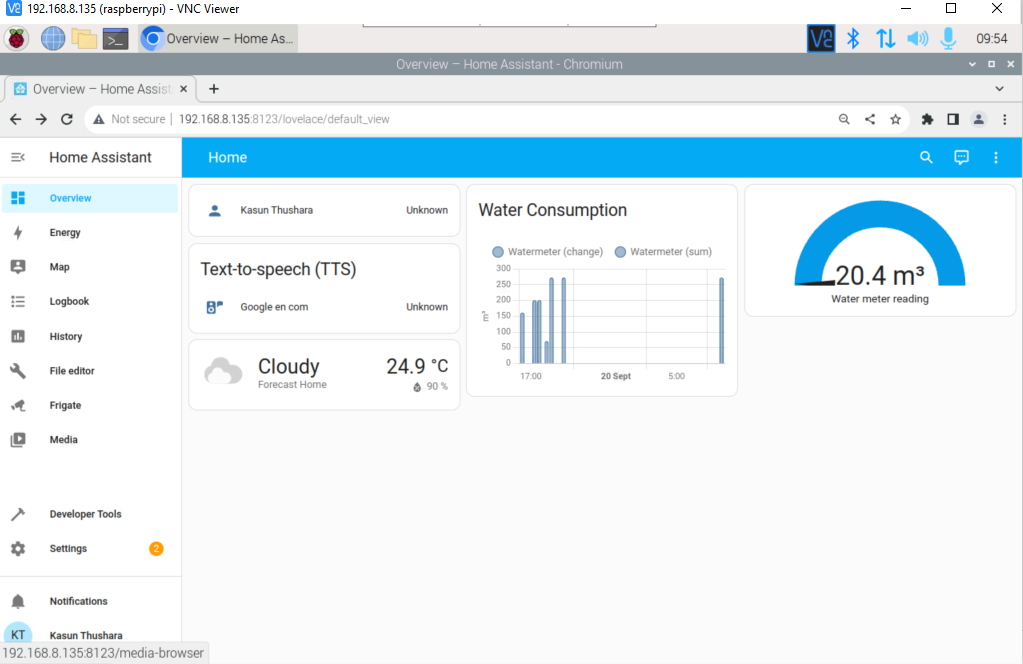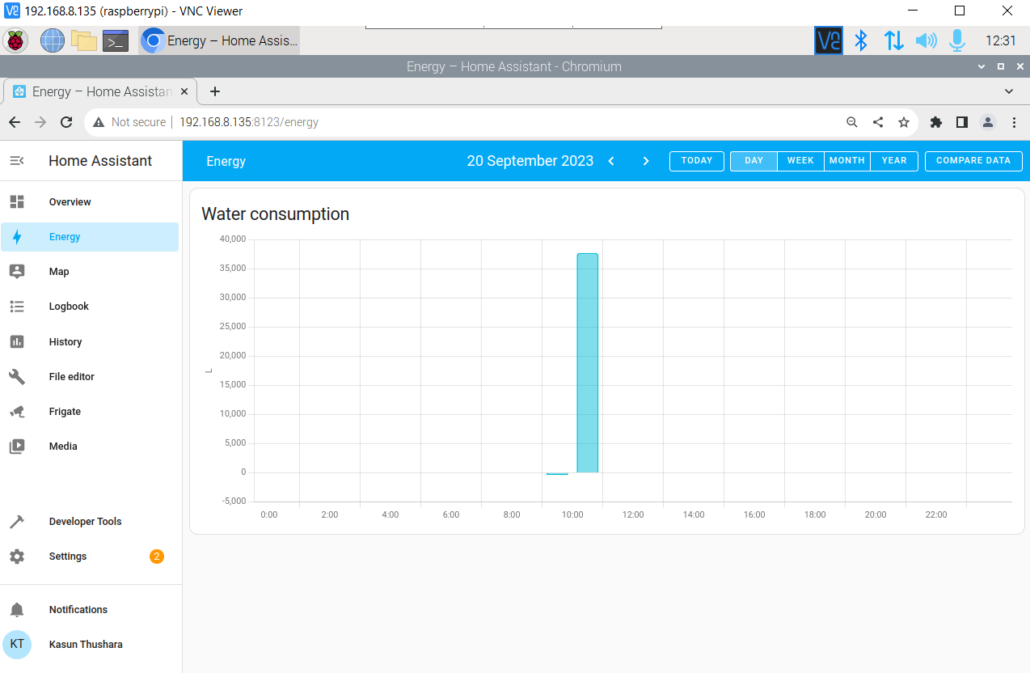A quick review: under the Home Assistant topic, We have talked about the following content recently:
- Integrating Seeed Studio reTerminal, Home Assistant OS, and Frigate with Coral AI USB TPU to create a smart and safe heaven
- Deploying Add-ons and Integrations for Home Assistant to Customize your Smart Home
- Installation Home Assistant on Docker Container
- Introducing the latest Home Assistant device: Home Assistant Green.
Today, we are gonna showcase a vision-based water meter monitoring and efficient water management demo with Home Assistant in this article.
Introduction
In the era of smart living, Home Assistant has emerged as a pivotal tool that revolutionizes how we interact with our living spaces. This open-source home automation platform not only simplifies our daily routines but also offers a wealth of possibilities for customization and integration. In this article, we delve into the importance and benefits of Home Assistant, exploring how it can transform your home into an intelligent and responsive environment. Additionally, we’ll unveil an intriguing project that combines Home Assistant with a crucial utility—water meter monitoring. As we all know, water is a precious resource, and managing it efficiently is essential for both conservation and cost savings. By the end of this article, you’ll not only understand the significance of Home Assistant but also discover how it can be harnessed to create a Home Assistant dashboard and integrate it with your water meter, providing you with valuable insights and control over your water consumption. So, let’s embark on this journey to explore the synergy between Home Assistant and smart water management, with a focus on key integration possibilities and project outcomes.

Integration with Existing Products
When it comes to monitoring water usage, there are several integrations available with existing products that make the task easier and more insightful. Products like Flo, Flume, and HomeWizard Energy are designed to provide you with detailed information about your water consumption.
DIY Approach with ESPHome-Based Devices
For those who enjoy a DIY challenge, there’s an intriguing option: ESPHome-based devices. These devices employ proximity sensors to detect a rotating magnet in your water meter. With each rotation, a pulse is generated and counted, effectively measuring each liter of water used. S0tool, an “Made for ESPHome” approved solution, offers a reliable and customizable way to implement this technology. By integrating such devices with Home Assistant, you gain the power to track your water usage precisely and access this data through your Home Assistant dashboard.
Innovative Vision-Based System
Taking a step further in your quest for efficient water monitoring, you’ve opted for a vision-based system using a Raspberry Pi Zero and Pi Cam. This innovative approach involves utilizing an efficient deep learning model, the Quantized INT8 version of the EfficientNet, and custom model training with a water meter dataset. This means that instead of relying on physical sensors, your system uses computer vision to “see” and interpret the water meter’s readings. By harnessing the capabilities of Raspberry Pi and a well-trained model, you’re creating a cutting-edge solution for monitoring water usage.
In this project, the Raspberry Pi and Pi Cam work in tandem to capture images of the water meter, and the custom-trained model processes these images to extract precise water usage information. This not only adds a layer of sophistication to your monitoring setup but also offers the potential for more accurate and detailed data about your water consumption.
Data Feedback via MQTT
Once the model has successfully analyzed the video stream, the data is sent back to the Home Assistant device via the MQTT protocol. This data includes precise information about water usage, enabling real-time monitoring and control.
Data Visualization on Home assistant dash boards
By configuring the configuration.yaml file and adding the water meter reading as a sensor, you can seamlessly integrate your water meter data into both your energy dashboard and your Home Assistant dashboard. This integration allows you to display not only the current water meter reading but also the daily water usage. It provides a comprehensive view of your water consumption patterns, making it easier to monitor and manage this vital resource efficiently.


While Home Assistant’s built-in Lovelace dashboard is a powerful tool for creating custom views and cards, you can take your home automation experience to the next level by exploring additional add-ons and custom dashboard solutions. Home Assistant offers integration with a wide range of third-party tools, including popular options like Grafana and InfluxDB. With Grafana, you can create visually appealing and highly customizable dashboards that provide deep insights into your data. InfluxDB, on the other hand, serves as a robust time-series database that stores and organizes your sensor data. By integrating these tools and creating custom dashboards, you have the flexibility to tailor your home automation experience precisely to your preferences and needs. Whether it’s visualizing energy consumption, water usage, or any other aspect of your smart home, these add-ons offer powerful ways to enhance your Home Assistant setup.
Conclusion
In conclusion, the integration of Home Assistant with a vision-based machine learning model for water meter monitoring is a groundbreaking step towards smarter and more efficient home automation. This project offers a multitude of advantages that can greatly enhance your home management:
- Precision Monitoring: The use of computer vision ensures highly accurate water meter readings, providing you with precise information about your water usage.
- Real-time Insights: With real-time data feedback via MQTT, you can monitor your water consumption instantly, empowering you to make immediate adjustments as needed.
- Energy Efficiency: By integrating this system into your energy dashboard, you can gain a comprehensive view of both your water and energy usage, helping you identify opportunities for conservation and cost savings.
- Customization: Home Assistant’s flexibility allows for tailored dashboards, ensuring that you can display the data that matters most to you in a visually appealing way.
- Sustainability: Efficient water management contributes to a more sustainable lifestyle, reducing water waste and environmental impact.
- Privacy: Storing data locally with Home Assistant ensures your privacy remains intact, as your sensitive information isn’t shared with external servers.
By harnessing the power of IoT, artificial intelligence, and Home Assistant’s open-source ecosystem, this project embodies the future of smart home management. It empowers you to take control of your resources, reduce waste, and ultimately create a more sustainable and responsive living environment.
Home Assistant Devices
When it comes to selecting the ideal hardware to run Home Assistant, Seeed Studio offers a range of products designed to seamlessly integrate with this powerful home automation platform.
reTerminal: a Raspberry Pi all-in-one board with an integrated touchscreen, Wi-Fi, and Linux OS, perfect for various applications including home automation.
reTerminal DM: takes it a step further with a 10.1″ industrial-grade screen and versatile connectivity options for more advanced use cases.
Home Assistant Yellow Kit: simplifies home control with extensive device compatibility and Zigbee support. The reRouter serves as a mini router with Raspberry Pi Compute Module 4.
LinkStar: equipped with powerful networking capabilities, suits both office and entertainment needs.
Home Assistant Green: offers an effortless setup with privacy in mind, storing data locally.
To get started with Home Assistant on these devices, you can follow the comprehensive installation guidelines available in the Home Assistant wiki, ensuring a smooth and user-friendly setup process for your smart home automation needs.